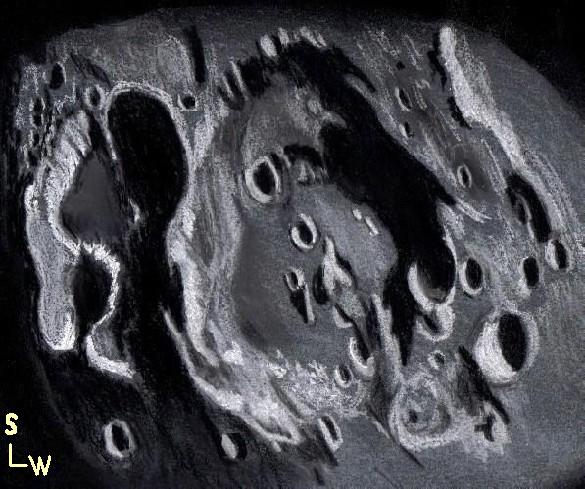Crater Maurolycus
Sketch and Details by Frank McCabe
This is a notable crater around the twentieth day of lunation as the setting sun shadows begin to crawl across the crater floor to the east. The large size (115 km.), central peaks on a flat floor and high terraced walls identify this ancient (Nectarian period) crater as a walled plain impact. The east wall rises steeply above the floor 4.2 kilometers. Part of a previous large crater juts out from under Maurolycus to the south. Central peaks casting shadows were seen north of the center point on the crater floor. The floor is mostly flat and smooth. In addition the floor is not believed to be lava flooded and in the October 2007 issue of Sky and Telescope, Chuck Wood describes a hypothesis that it may be covered with fluidized ejecta from basin formation. The problem with this notion as he points out is that basin formation ended before the Maurolycus forming event occurred. Among the many similar craters in the southern highlands this is a crater that truly stands out.
Sketching:
For this sketch I used: black Strathmore 400 Artagain paper 9”x12”, white and black Conte’ pastel pencils and a blending stump. After scanning, Brightness was decreased (-4) and contrast increased (+4) using Microsoft Office Picture Manager.
Telescope: 10 inch f/ 5.7 Dobsonian and 6 mm eyepiece 241 x
Date: 7-23-2008, 5:45-7:10 UT
Temperature: 20° C (68° F)
Partly Cloudy, calm
Seeing: Antoniadi III
Colongitude 154.2 °
Lunation 20.2 days
Illumination 76.3 %
Frank McCabe


Frank,
It’s a beautiful sketch!!
The sun seems to reflect on the crater rims on my screen. Well done!
Rony
Rony,
Thank you for the kind words. I really enjoyed doing this sketch.
Frank